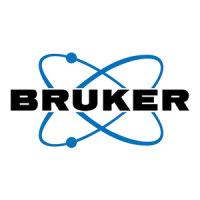The M4 TORNADO Software
M4 TORNADO
35
5 The M4 TORNADO Software
5.1 Program Description
The M4 TORNADO is delivered with the software program M4 TORNADO, which is based on
ESPRIT (Bruker’s comprehensive analytical software suite).
The program controls the complete instrument, including the measurement and quantification
procedure. It allows:
setting of measurement parameters like HV, tube current, filters, measuring time, etc.
control of stage position via joystick or mouse settings
control of camera systems and optical microscopes
control of the measuring process and accumulation of spectra
realization of different measuring procedures like point, line and area for single point analysis
and elemental distributions
selection of quantification procedures
qualitative analysis by peak identification
quantitative analysis by different models for homogeneous samples or layer systems
generation of analysis reports
The program is Windows
®
-based and offers high convenient handling due to intuitive graphic user
interface. It allows the control of the instrument and a sophisticated spectrum evaluation and
quantification.
5.1.1 Start-up and Login
The M4 TORNADO software runs on the M4 TORNADO server and the client workstations.
However, the user only has to start the client application; the server software and communication
drivers will start and log in automatically.
A desktop icon and an entry in the Start menu serve for starting M4 TORNADO. A username
and password are required for logging in. With multiple client installations a user can log in from
any client workstation and access his private data and user profile on the M4 TORNADO server.
With multiple M4 TORNADO servers in the network, the server to connect to is selected during
log in procedure. A list of available servers is provided below the password entry box.
5.1.2 Main menu
The screen area on the left-hand side of the M4 TORNADO program window displays the main
menu in form of buttons for selecting a workspace. The different workspaces define the general
functions. In full screen mode the main menu is displayed as aline at the top of the program
window.
The software is structured as shown in Fig. 8.

